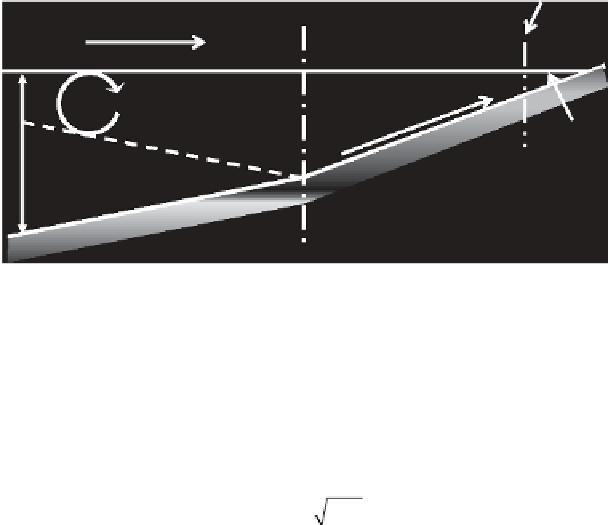Environmental Engineering Reference
In-Depth Information
Deep water
Shore zone
Breaker line
Increasing waves
Wave form
distorted by depth
Wave-mixed layer
Swash zone
D
D
=
4/3
H
D
=
λ/2
FIGURE 13.4
Schematic of surface waves. (Redrawn from Ford, D.E. and Johnson, L.S., An assessment of
reservoir mixing processes, U.S. Army Engineers Waterways Experiment Station, Vicksburg, MS, 1986.)
Both short and long waves are gravity waves whose wave speed or celerity is dependent upon
gravitational acceleration. The short wave speed or celerity depends on the wavelength, while for
long waves, the wave speed or celerity is a function of the water depth. For example, the celerity (
c
)
of a long wave may be estimated from gravitational acceleration (
g
) and depth (
D
):
cgD
=
(13.3)
13.2.2 b
reakInG
w
aVeS
As short waves enter shallow water, interaction with the bottom begins to affect the orbital motion,
as shown in Figure 13.4. The bottom interaction begins when the depth decreases to less than one-
half of the wavelength (
L
in Figure 13.3 or λ in Figure 13.4). From this point inland to the breaker
line is the shore zone where the depth is less than λ/2. In the shore zone, the wave velocity decreases
with the square root of the depth, which results in a corresponding increase in the wave height.
Waves distort as water at the crest moves faster than the wave, creating instability. These unstable
waves may eventually collapse, forming breakers or white caps, as illustrated in Figure 13.4. The
type of breaker that is formed depends on the wave steepness, the wind speed and direction, the
direction of the wave, and the shape and roughness of the bottom. A spilling breaker (Figure 13.5)
tends to form over a gradually shoaling bottom and tends to break over long distances with the wave
collapsing downward at the front of the wave. Plunging breakers (Figure 13.5) occur when the bot-
tom shoals rapidly or when the wind direction opposes the wave. The plunging breaker begins to
curl and then collapses before the curl is complete. A plunging or surging breaker does not actually
break or collapse but forms a steep peak as the wave moves up the beach. This type of breaking
wave and the associated energy controls beach erosion, aquatic plant growth, surf zone mixing, and
the exchange of contaminants between the surface water and the groundwater.
After breaking, waves continue to move up a gradually sloping beach until the force of gravity
forces the water back. The extent to which the water runs up the beach is called the swash zone. The
movement of the swash up the beach may result in the deposition of particles and debris, resulting
in swash marks at the highest point of the zone.
13.2.3 L
anGMuIr
c
IrcuLatIon
In very large lakes, seas, and oceans with a very long fetch, a series of parallel pairs of large verti-
cal vortices or circulatory cells, known as Langmuir circulation, develop in the general direction of

Search WWH ::

Custom Search